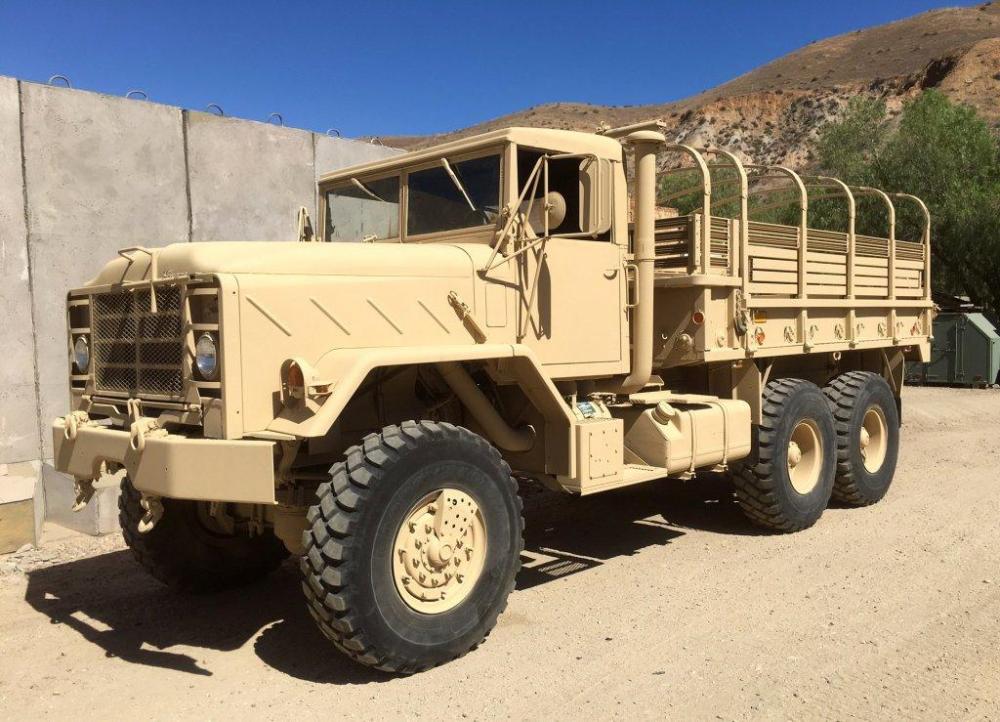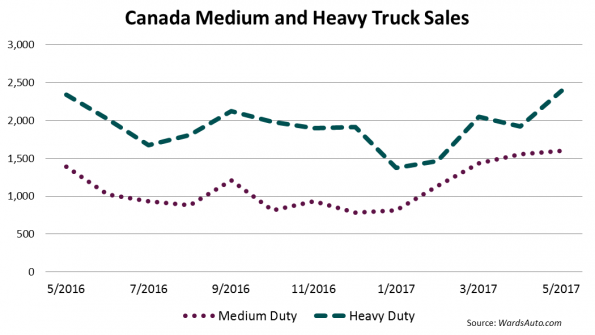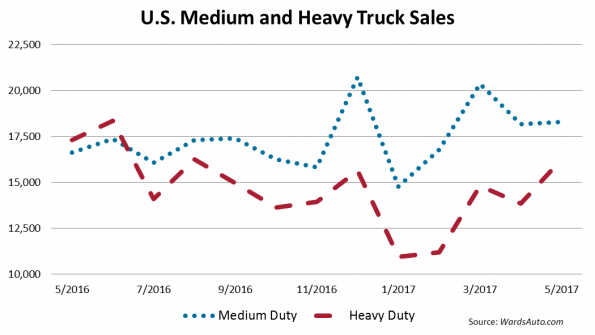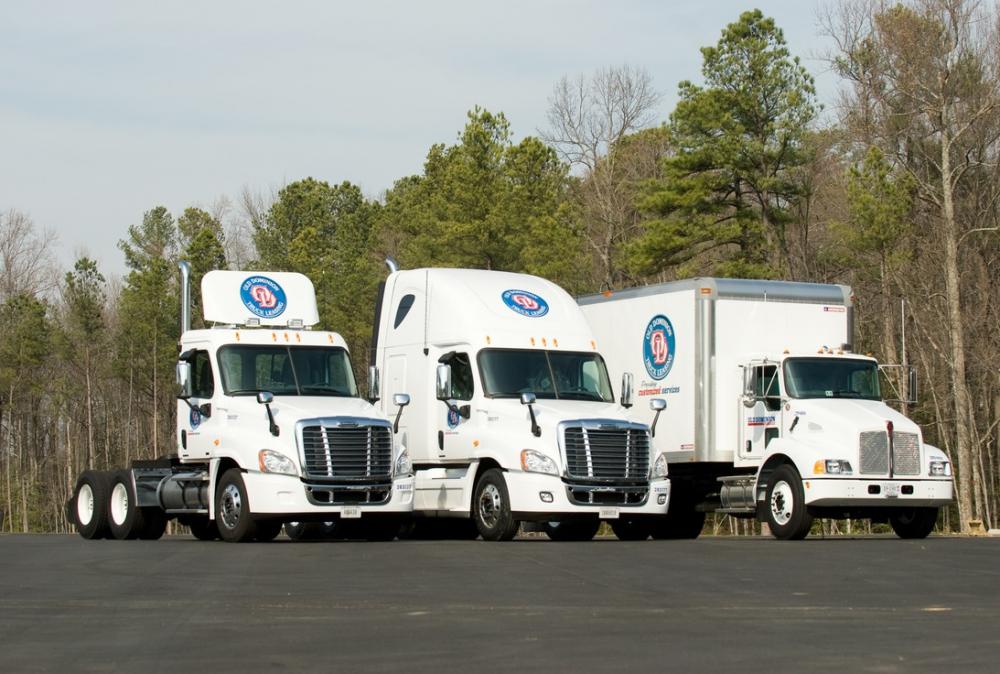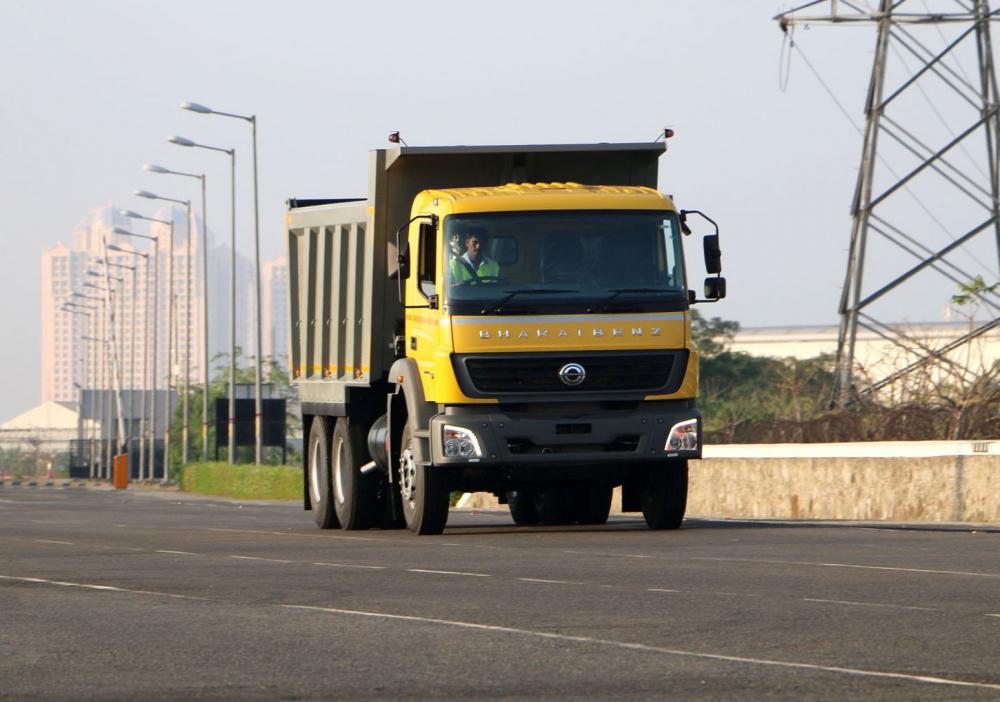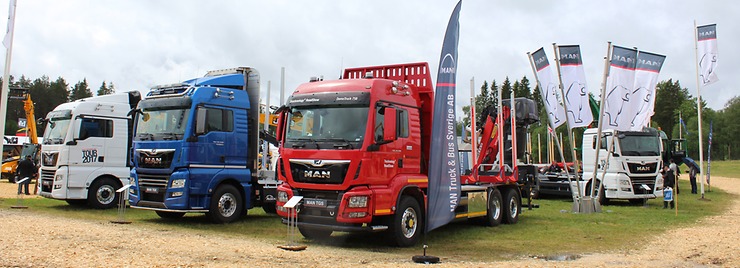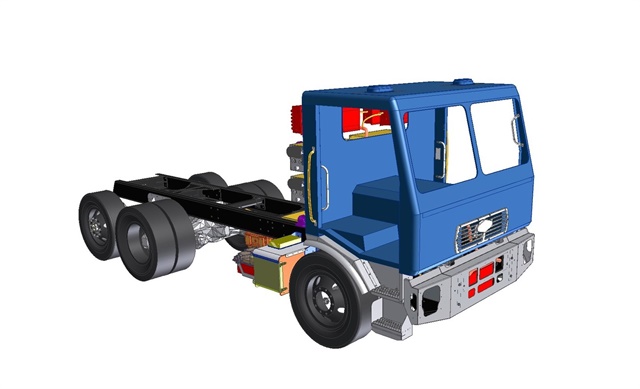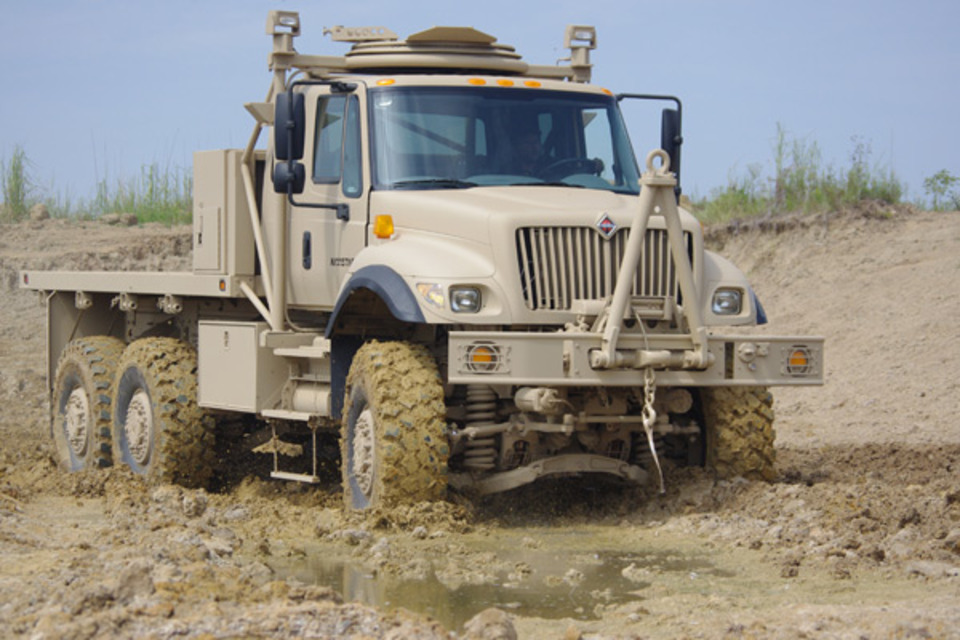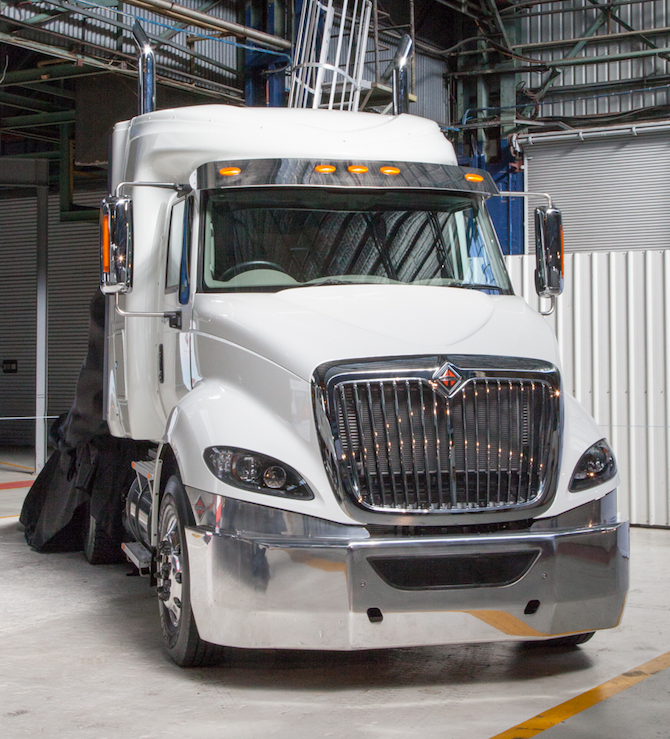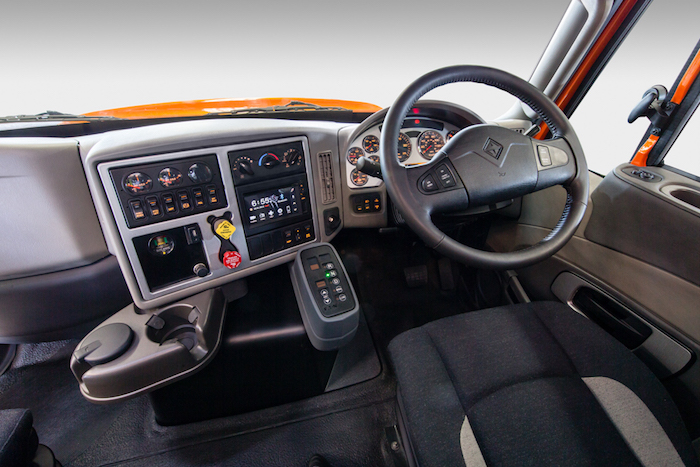
kscarbel2
Moderator-
Posts
17,893 -
Joined
-
Days Won
86
Content Type
Profiles
Forums
Gallery
Events
Blogs
BMT Wiki
Collections
Store
Everything posted by kscarbel2
-
Scania Group Press Release / June 12, 2017 Europe’s truck manufacturers have presented a detailed timeline of steps leading up to the introduction of convoys of semi-automated trucks on Europe’s motorways before 2025. The EU Roadmap for Truck Platooning also provides guidance to policy makers and authorities on the regulatory changes and political support necessary for cross-border truck platooning. “The technology for platooning with trucks of the same brand is already available today. But clearly customers will need to be able to platoon with trucks of different brands, so our next objective is to introduce multi-brand platooning,” said Erik Jonnaert, Secretary General of the European Automobile Manufacturers’ Association (ACEA), when he presented the roadmap to the European Parliament. Autonomous trucks By 2023, it should be possible to drive across Europe on motorways with multi-brand platoons, without needing any specific exemptions for crossing national borders – a prerequisite for international transport. Subsequently, allowing the driver of a trailing truck to rest might come under consideration. However, full autonomous trucks will only come later, according to Jonnaert. While Scania and other manufacturers are already exploring the business case for truck platooning with the logistics sector, certain conditions that need to be met before 2023 are beyond the control of the truck industry. “That’s why we will also need to strengthen cooperation between all players involved, including operators of road infrastructure, transport companies, regulators and insurance companies, but policy makers in particular.” Europe will need to create a supportive regulatory framework before truck platooning can become a common sight. “And that’s exactly where the policy makers come in. They will need to develop new rules, make changes to existing legislation, and harmonise international and EU rules,” said ACEA’s Erik Jonnaert.
-
If you mean sell Afghanistan 115 used M923A2's, I'm all for it. So long as the US taxpayer isn't paying for it. .
-
Wards Auto / June 14, 2017 The Canadian big-truck industry had a good month in May, up 2.7% from year-ago with small drops in Classes 6 and 8. With one more selling day this year than last, truck makers sold 3,996 units compared to 3,734 in like-2016. Class 8 ended May with 2,395 deliveries, a 1.8% decline from year-ago. Daimler’s Freightliner and Western Star saw double-digit losses of 14.9% and 23.5%, respectively, resulting in a 17.1% fall for the company. Similarly, Volvo Truck slumped 19.9% with Mack (-4.0%) and Volvo (-27.9%) underperforming. Paccar, however, climbed 39.5% and increased market share from 21.0% to 29.9% with big gains from Kenworth (+42.3%) and Peterbilt (+35.8%). International rose 17.4% to 329 units. Five months into the year, Class 8 followed 4.3% behind like-2016 with 9,209 deliveries compared with 9,619. Medium-duty truck sales delivered an all-time high for the year at 1,601 units, a 10.4% increase from year-ago’s 1,392. Year-to-date sales were 13.9% ahead totaling 6,543 deliveries. Sales in Class 7 totaled 416 units, a 20.7% spike from last year’s 331. Large gains were seen from Kenworth (+117.8%), Peterbilt (+50.4%) and Hino (+30.7%). International also had a good month with deliveries increasing 12.3% to 131. Ford and Freightliner floundered with declines of 55.7% and 14.0%, respectively. Class 6 sales remained nearly flat with a 0.7% slip on 119 deliveries. Volume leader Hino plummeted 23.2% and lost 12.8 percentage points in market share. Ford sales were nearly a third of what they were last year, dropping to only five units, and Freightliner’s deliveries were cut in-half, down to 11. International saw the biggest improvement in May, soaring 604% to 22 units from 3 in 2016. Paccar also hit triple-digit gains with Kenworth (+92.0%) and Peterbilt (+135.6%) totaling 29 sales for the month. The 11.2% gain in domestics helped offset a 24.8% decline in imports for Class 5. Ford accounted for most of the gain in domestics, hitting 358 units and 44.0% market share. FCA also helped with a 16.8% spike to 180 units. International posted a 188.0% increase but on small volume. Isuzu’s import line fell 25.1% to 117 deliveries. Class 4 performed the best of any class last month, with demand jumping 24.6% to 253 trucks. Ford sales spiked 87.6% to 170 units, accounting for 67.2% of the market share. Runner-up Isuzu posted a 48.6% drop in domestics but was able to double its import sales to 21 units. Hino rose 22.2%, while Daimler undersold 4.0%. Canada sales of medium- and heavy trucks in May outpaced like-2016 by 2.5% for the year’s largest monthly gain. .
-
US Heavy Truck Sales Continue to See Year-Over-Year Losses
kscarbel2 posted a topic in Trucking News
Wards Auto / June 14, 2017 Despite large gains in Classes 5 and 7, U.S. medium- and heavy-duty truck sales fall in May, dropping 2.3% to 34,550 units. Year-to-date sales continued to slip, declining 10.3% to 155,418 from like-2016’s 173,212, primarily due to large monthly losses in Class 8 sales. Sales in Class 8 fell 9.9% to 16,248 units. Volvo and Mack were the primary culprits, with freefalls of 26.9% and 18.0%, respectively. Volume-leader Freightliner tallied 6,900 sales, compared with prior-year’s 7,012, while Western Star totaled 405 compared with 463 in like-2016. International also saw a decrease, dropping 15.3%. Peterbilt brought the only gain in the group, a meager 0.4% from 2,347 to 2,454 units. The small gain couldn’t offset the large 10.4% loss from Kenworth, bringing Paccar down 5.3%. With another month of losses by nearly all manufacturers, Class 8 year-to-date sales were lagging 21.9% behind year-ago with 67,021 deliveries. Medium-duty truck sales saw a 5.6% increase in May despite the double-digit loss in Class 6. Through May, Classes 4-7 were tracking 1.1% ahead of like-2016. Class 7 sales rose 5.8% in May with help from International’s 24.1% boost to 1,240 units. Group leader Freightliner increased 2.4% but dropped to 50.6% market share from 52.4% in like-2016. Ford sales totaled 167 units, down 6.8% from 2016’s 172. Hino grew 23.3% to 149 units. Small demand for Kenworth (-17.1%) and Peterbilt (+8.5%) resulted in a 4.6% decline by Paccar to 896 deliveries. With a large 39.4% loss by Ford, Class 6 was the only medium-duty group to see a decline in May. Ford lost 10 percentage-points in market share, slipping to 1,101 deliveries from year-ago’s 1,743. Freightliner swooped in and increased its market share 10 percentage points with a 17.0% increase in sales. International dipped 19.0% on high volume. Peterbilt soared 495.2% to 31 units, and Kenworth grew 26.0% to 210. With increases by both domestics and imports, Class 5 managed an 18.5% increase over like-2016. International performed the worst in the group, plummeting 85.2% to 12 units. Group leader Ford gained 21.9% in sales and increased to 61.3% market share. Daimler’s Freightliner (+27.1%) and Mitsubishi Fuso (+37.1%) saw large gains. FCA grew to 1,543 deliveries, up 15.5% from 1,282. In a similar situation, Class 4 sales were up 26.2% with large increases by domestics and imports. Mitsubishi Fuso soared 132.6% on small volume. Isuzu’s domestic line dropped 3.1% on large volume, while imports rose 47.0%. International (-52.0%) and Ford (-12.8%) also underperformed in May. Class 8 held 347,148 units in stock at the end of May, down from 50,657 year-ago. Days’ supply fell 18 days to 53. Medium-duty stock swelled to 62,040 units, compared with like-2016’s 60,926. Days’ supply fell three days, to 85. . -
Today’s Trucking / June 14, 2017 LINCOLN, NE--Midwest American carrier Crete Carrier Corporation is upping the maximum speed for company drivers from 62 mph to 65 mph. Many fleets including Crete Carrier, Shaffer Trucking, and Hunt Transportation, have been limiting their vehicle speed for two very important reasons—safety and fuel economy. However, according to Crete, recent years have seen "significant advancements in technology and aerodynamics that have had a major impact on these factors. Technology such as collision mitigation, roll stability, and adaptive cruise control, have improved safety. Crete, Shaffer, and Hunt have spent millions of dollars investing in these products and others to help our great drivers be even safer while on the road. "Fuel economy is the second factor in limiting vehicle speed because fuel is one of the largest operating expenses trucking companies incur. Wind resistance works against a truck as it goes down the road. Other factors include grade and tire rolling resistance, and drivetrain losses. Crete’s truck and trailer suppliers continue to evaluate and innovate how they build their products to make sure they are doing everything they can to help lower fuel consumption. Continued investment in late model equipment allows Crete Carrier Corp to stay on the leading edge of fuel-efficient equipment. In addition, utilizing software technology that helps the company plan and optimize fuel routing makes sure fuel is purchased at the best prices. "When making this decision, Crete evaluated many factors including the ones mentioned earlier. The evaluation concluded that the company could make this change without compromising our Seven Principles, the most important being Safety First and Foremost. Crete would never sacrifice the safety of drivers or those whom drivers share the road. Crete’s CSA scores are among the top of in the industry – proof of its commitment to safety."
- 1 reply
-
- 1
-

-
Fleet Owner / June 14, 2017 New tire focuses on traction upgrade in effort to reclaim some share in the market. MONTREAL, QUE. Michelin is getting ready to launch a new regional drive tire on July 1 that it expects will trump its previous regional drive tires and be more in line with what fleets want. Ralph Dimenna, COO of Michelin Americas, truck tires, told Fleet Owner during Michelin’s "Movin On" mobile sustainability event in Montreal the new tire is an effort to reclaim some share in a part of the market where it hasn’t quite delivered the optimal product for fleets. “There is a 60% to 65% increase in longevity and a real big upgrade in traction, which is where we kind of had a problem," Dimenna said about the tire. "We’ve had a very low fuel-economy tire, but the traction hasn’t been what the market wanted. But we have a great increase in traction on this new product.” The new tire will contain radio frequency identification (RFID) chips, which the company said it would add to each of its truck tires to provide better tire life data to its fleet customers. RFID tags allow fleets to better track their tire assets and better understand the lifecycle of their tire casings. “We are starting to see some fleets that are starting to think more about how they are going to use [RFID tags] and how it can help them improve their operations and improve their overall cost of doing business,” Dimenna noted. “That’s the exciting part about the RFID – it really changes the conversation from just ‘what product do I have, but to how is that product helping me manage my business better.’ ” During a separate press conference, Serge Lafon, executive vice president of the truck product line at Michelin, explained that within two to three years, all Michelin tires will include RFID tags. Not only do the tags trace tire pressure and determine when a tire needs to be replaced, but they also can be used to exonerate a fleet and prove proper maintenance has been done if the need arises, Lafon said. “When a fleet – a coach fleet, for example that carriers passengers – is in an accident they have to prove the fleet has been maintained and repaired properly,” Lafon explained. This, he said, is when data from RFID tags becomes essential. Lafon also mentioned that Michelin is developing a mobile app for its Michelin Tire Care service, which was launched in 2015 and is designed to assist fleets in identifying tire issues that lead to downtime, low mileage, high fuel costs and safety risks. And when it comes to emissions reduction and fuel efficiency efforts, Dimenna told Fleet Owner that though Michelin is watching future greenhouse gas (GHG) emission requirements, the company tries not to predict the regulatory front. “We understand that fuel efficiency and CO2 emissions are top of mind for many fleets,” he explained. “We think it’s long term, not a conversation that’s going to change. Whether there’s any change in the short-term or any timing of regulations, I’d say that’s a secondary question. We want to be a leader in that space. We think it’s important to our customers, it’s important to the Michelin brand to be a leader in terms of fuel economy, and it’s important to our business on the commercial truck side as well that we can combine exceptional fuel economy with the other attributes that are important to fleets.” Regarding some of the main challenges in the heavy-duty trucking industry, such as driver retention and freight rates, Dimenna said Michelin is trying to better understand those issues for its customers when determining the type of product and services it releases. And when it comes to sustainable mobility, Dimenna said it is no longer a movement, but an expectation. “I think regardless of market, we hear the same thing everywhere we go: People are concerned about the impact we are having on this planet,” he noted. “We want to be a durable partner and make sure we are a thought leader and actionable leader in the way we treat our responsibility to the environment.”
-
Cummins to put fully electrified powertrain system on road in 2019
kscarbel2 replied to kscarbel2's topic in Trucking News
Cummins commits to electrification and more Today’s Trucking / June 14, 2017 INDIANAPOLIS, IN – Cummins is pledging to launch a fully electrified powertrain in 2019, and a range-extended electric powertrain in 2020. But senior executives stress that these rollouts will be for urban transit vehicles, and that electrified long-haul trucks are still years from reality. “We are not just a diesel engine company,” proclaimed Chief Executive Officer Tom Linebarger, during a Wednesday conference call. “Technology is what we do. Innovation is what we do.” An internal electrification business group is combining Cummins expertise with selected partners, as they collectively develop power storage, related electronics, and traction motors. With the falling cost of batteries and electronics, vehicle electrification is already economically viable when combined with the right duty cycles and operational characteristics, said Julie Furber, electrification business development executive director. Examples of those applications are found in urban, material handling, and underground environments, according to Cummins. While the current U.S. administration recently pulled out of the Paris Climate Accord, and proposed funding cuts to the U.S. Environmental Protection Agency, Linebarger stresses that cities have been the primary drivers behind electrification. That’s where lawmakers are looking to control emissions, reduce noise, and relocate traditional fueling stations, he said, responding to a question from Today’s Trucking. “All those get better with electrification.” Cummins executives, meanwhile, say they are well positioned to bring such technologies to market – thanks to existing relationships with Original Equipment Manufacturers and an established global service network. “Our competitors will not be able to scale up from the passenger car,” Furber said, in an apparent nod to Tesla’s plans to introduce a Class 8 electric vehicle by September. “For a long-haul vehicle, we think that’s out quite way into the future,” says Chief Technical Officer Jennifer Rumsey, referring to the challenges of battery size and weight. “We are looking at mild hybridization.” Cummins engineers are looking well beyond electrification, too. “We see a trend away from diesel and we will continue to evolve,” said Rumsey. Identified long-term options range from biofuels to synthetic fuels and hydrogen. “Natural gas has big potential,” she added. Don’t expect diesel to be abandoned anytime soon, however. Cummins officials say they are working on an engine that is smaller and lighter than the X15, which will target aerodynamic conventional and cabover trucks used in markets such as China, Mexico and Brazil, all of which are preparing to adopt tighter emission standards in the next two years. Linebarger stressed that Cummins is also approaching business in a different way. “We will actively look for ways to disrupt ourselves,” he added. A new Growth Office has been established to evaluate hundreds of ideas and see how they can be integrated. That recently led to the creation of the Eaton Cummins Automated Transmission Technologies joint venture. Cummins is also working with Microsoft on a new natural gas fuel cell, currently being tested in Seattle. It’s looking at more than hardware, too. Cummins will be involved in launching a smartphone-based Electronic Logging Device in the next week or so. That’s one of the projects under a new digital accelerator that will guide projects from concept stages to commercialization, Linebarger said. -
Truck News / June 14, 2017 INDIANAPOLIS, Ind. – Cummins has announced it will have a fully electrified powertrain system available for its customers and on the road by the end of 2019. Making the announcement via teleconference June 14, Julie Furber, executive director of electrification business development for Cummins, said in addition to the 2019 release, the company will also unveil a range extended electric vehicle by 2020. “We believe that we know some things about electrification that maybe others don’t,” Furber said. “The first commercial markets that we see moving are transit bus, pick-up and delivery, and material handling. And then longer term, we believe that electrified power will come to all of our markets in one way shape or form, but not tomorrow, and not next year, despite all the chatter you may be hearing.” Furber said there will be several factors pushing toward the electrification of vehicles, including regulations on emission levels and internal combustion engines, noise reduction in urban environments, and increased social pressure and expectations for environmental sustainability. Tom Linebarger, Cummins’ chairman and CEO, said the company was increasing its investment into electrification, as well as telematics and digital technology, but is also maintaining its investment into diesel, as the company believes the fuel will endure in several markets for years to come. Linebarger did, however, emphasize that Cummins was not simply a diesel engine company, as many have come to recognize them, but rather go far beyond that. “We are a technology company,” Linebarger said. “Technology, innovation and empower is what we do. The trucking industry was built on the back of Cummins.” Linebarger said electrification was coming, particularly in the urban market, and that Cummins would not only look internally to bring advanced technologies to customers, but also externally, which is why the company is able to be a leader in electrification, telematics and digital technology. “There’s no question that electrification is here,” he said, “and we have real experience in this market. “Innovation for long-term growth is our focus today. We will actively look for ways to disrupt ourselves, rather than allow others to disrupt us.” Furber, who leads the company’s electrification unit which was launched earlier this year, said one of the biggest hurdles for electric vehicles in the past was cost, something that has come down in recent years making them a more viable option for many customers. On the engine side, Jennifer Rumsey, chief technical officer for Cummins, said the company’s next generation heavy-duty engine, which is currently under development, will provide improved efficiency and power from a package that is smaller and lighter than its current X-15. She added that Cummins sees an opportunity to provide engines to countries around the world that are looking to improve emissions standards in the coming years. “We believe this continued focus on the engine system is critical,” Rumsey said, “but a broader focus on the power system is necessary to provide a market-leading solution to our customers.” Rumsey highlighted the Eaton-Cummins automated transmissions technology as a key area of focus for the company, which will design, develop, and sell current and future automated transmission for medium- and heavy-duty applications globally. Rumsey also touted the company’s efforts when it comes to alternative fuels, saying, “While we believe it’s important not to lose our focus on the diesel power system, we also recognize the importance of developing alternative energy options.” Cummins has invested in new natural gas technologies for on- and off-highway, as well as being ready for any potential moves toward bio-fuels, synthetic fuels, and hydrogen. “Cummins is doing all the right things in the right way,” said Furber. “And we are prepared to disrupt, to grow, and keep becoming better and better.”
-
Fleet Owner / June 14, 2017 Deal will add some 1,400 tractors, trucks and trailers to Penske’s fleet. Penske Truck Leasing is entering into an agreement to acquire Richmond, Virginia-based Old Dominion Truck Leasing. Financial terms were not disclosed. “Old Dominion Truck Leasing and Penske Truck Leasing customers will benefit from synergies in our products, technology, and services available across our combined network of facilities,” noted Brian Hard, president and CEO of Penske Truck Leasing, in a statement. “We share a strong commitment to service and will continue to enhance the high-quality service their customers have come to expect.” Old Dominion Truck Leasing serves approximately 360 customers in diverse industry sectors from 11 locations in five states and Hard said its products and services align well with Penske’s existing service offerings that includes full-service truck leasing, truck rental, contract fleet maintenance, and dedicated contract carriage. The acquisition adds approximately 1,400 tractors, trucks and trailers to Penske’s fleet. The transaction, subject to customary closing conditions, should be finalized in July. .
-
We can no longer be the world's policeman, nor can we afford to be. I can't see the point of brave Americans putting their lives on the line for a country on the other side of the world whose government is utterly corrupt and allows the production of opium for global heroin distribution. It's not our neighborhood, not our battle. 2001 to present day 2017......that's long enough to realize that it's a never-ending fight. The Soviet Union learned their lesson and threw in the towel. .
-
It seems the 7.6-litre MaxxForce DT, a massive evolution forward of the venerable DT466, is only still available for export and military applications and has been rebadged as MaxxForce 7.6D. In civilian use, it was replaced last year by the popular Cummins ISB. https://www.navistardefense.com/NavistarDefense/mobile/engines/maxxforce76d https://www.navistardefense.com/NavistarDefense/mobile/engines/ (Some of these engines are produced by Navistar's Brazilian MWM engine unit..........http://www.mwm.com.br/site.aspx/Home-En) https://www.internationaltrucks.com/engines (The N9 is based on the DT570 architecture, and the N10 is based in the HT570)
-
Jay Leno's Garage - Restoration Blog: June 2017
kscarbel2 replied to kscarbel2's topic in Odds and Ends
I really enjoy Jay's restoration updates. It's kind of him to take the time. It speaks volumes about his human nature and passion for motorized vehicles. -
You and I, the U.S. taxpayer, in the name of regime change.
-
Daimler Press Release / June 13, 2017 50,000 BharatBenz trucks on Indian roads in less than five years 10,000 additional vehicles exported Next step: export of sub-9-ton truck to start in Q3 2017 Update of entire domestic truck portfolio completed Stuttgart / Chennai - Less than five years after its market introduction, Daimler India Commercial Vehicles is passing a major milestone: 50,000 BharatBenz trucks are already on Indian roads. In addition, more than 10,000 trucks have been exported to more than 30 markets since. This kind of ramp-up has never been achieved by another market entrant in India before. BharatBenz was created specifically for the Indian market. The Indian Commercial Vehicles brand from Daimler also recently completed the full-range portfolio update with the launch of the all-new BharatBenz heavy-duty range. Furthermore, India has become an important export hub for Daimler Trucks since 2013. Export numbers have doubled for several years in a row and build the ground for the next big step: The start of a new sub-9-ton truck for markets in the Middle East in the third quarter this year. Strong standing in the world’s toughest CV market With the market launch of the BharatBenz brand, Daimler had dared a bold step into the world’s toughest commercial vehicle market – dominated by long standing domestic brands. This courage pays off now: While India had not even been part of the Top Ten markets for Daimler Trucks until 2014, it now ranks as fifth important market for Daimler Trucks worldwide – with 13,100 units sold in 2016. Global hub serving more than 30 markets with export vehicles Besides the strong domestic standing, India serves as an important export hub: 10,000 trucks have been exported from DICV’s state-of-the-art production plant at Oragadam near Chennai since the start of the vehicle exports in June 2013. In 2016, exports from India again doubled up to more than 4,000 units. The FUSO and Mercedes-Benz vehicles for export are manufactured on the same production lines as the domestic BharatBenz portfolio. The trucks already get exported to more than 30 markets in Asia, the Middle East, Africa and Latin America. Within this year, this number will grow up to 40 markets on three continents, including Bahrain and markets in Africa and Latin America. All exported trucks are leading in terms of safety, reliability and efficiency and fulfil the diverse requirements of customers in the different target markets. Complete update of the Indian truck portfolio With the launch of the all-new BharatBenz heavy-duty truck range in April 2017, DICV completed the update of the whole domestic truck portfolio in less than five years since the market launch. Productivity, efficiency and safety are the core topics of the new portfolio. The new heavy-duty range vehicles bring real benefits for the Indian customers with improvements in fuel efficiency by a double-digit percentage combined with lower maintenance costs. BharatBenz also clearly led the India’s CV segment in the country’s recent transition to the new BS-IV emissions standard. The whole BharatBenz portfolio had already been available with BS-IV from August 2015. When the full transition to BS-IV vehicles became reality on 1st of April 2017, BharatBenz already had delivered more than 1,000 vehicles with this new standard to customers. The BS-IV solution is based on proven SCR technology, which is used in Mercedes-Benz trucks since years and constantly evolving. BharatBenz – made in India, made for India The BharatBenz brand is customer-tailored for the Indian market and its demanding customer requirements. First unveiled in February 2011, it celebrated its market launch in September 2012. Soon featuring a full-fledged product portfolio in the medium- and heavy-duty segments, the brand crossed the first major milestone of 10,000 units in April 2014 and has further accelerated its growth from there. With the update of the medium-duty range in 2016 and the all-new heavy-duty range in 2017, BharatBenz updated its entire truck portfolio within a short span to give customers even more value for their money. BharatBenz products are sold and serviced through a pan-Indian network of more than 130 touchpoints which is continuously expanded further also beyond the tier-2 and tier-3 cities. .
-
Competence for the timber industry: MAN at Elmia Wood 2017
kscarbel2 posted a topic in Trucking News
MAN Truck & Bus Press Release / June 13, 2017 MAN exhibits its extensive range of products for the first time at the leading forestry trade fair // MAN presents a comprehensive portfolio for the entire forestry value chain at Elmia Wood with its TGX, TGS and TGL From 7 to 10 June, MAN demonstrated its proven competence to the timber industry at the world's largest Forestry trade fair. Every four years, the global timber industry convenes in a vast area of forest near Jönköping in Sweden. Over 500 exhibitors present important technical trends and current innovations for the timber economy to some 60,000 visitors from 50 countries, mostly professionals in the sector. And this all takes place in a natural working forest environment, because the extensive exhibition grounds are situated in the middle of the forests south of Lake Vättern. For MAN, this application-oriented industrial fair gives it the ideal opportunity to demonstrate its proven expertise in vehicle solutions for transporting timber. Seven MAN TGX, TGS and TGL models were exhibited in the Load & Transport category at Elmia Wood 2017, providing a wide selection of top-notch vehicles to meet specialist needs. An expert on high-performance drives, MAN showcased the top-of-the-line 640 hp engine, newly introduced at German’s 2016 International Motor Show, in the form of a TGX as a short-log transport vehicle in a classic 6X4 chassis version. This D38 engine, with its maximum torque of up to 3000 N m, provides sufficient power reserves for even difficult conditions, making it especially suitable for timber transport. As an alternative to this maximum power version, D38 engines are also available with 540 and 580 hp. And then there is the D26 engine, also introduced in 2016, which covers lower power ratings from 420 to 500 hp with a torque range of up to 2500 N m. In combination with its new generation of MAN TipMatic gearboxes, with numerous luxury functions and a range of application-specific driving programmes, MAN offers a finely-graded drive-train portfolio with especial provision for off-road applications. Not only high performance reserves, traction also has an important role to play in forestry operations. For this, MAN’s fair booth presented a fully equipped Elmia Wood edition of its 500 hp MAN TGS 6X4H4 with additional HydroDrive hydrostatic front wheel drive. This traction assistance system, which is active up to 28 km/h, offers additional traction reserves to ensure that sufficient grip is available in every situation, even on loose ground or undeveloped forest paths. On steep descents, the HydroDrive also applies additional braking torque to the front wheels, thus significantly improving the safety of forestry deployment. MAN also fielded a TGX PerformanceLine 8X4 – 4 with 640 hp to illustrate the manoeuvrability and loadability that are also called for when transporting timber. This short-log truck, designed with the Finnish market in mind with a permissible overall weight of 37 tonnes, has an Alucar body and Epsilon crane plus two driven rear axles supplemented by a steered trailing axle. This triple-axle configuration allows for high payloads with maximum manoeuvrability. The trailing axle can also be raised for unloaded journeys. The fact that forestry trucks are not only used for transporting timber, but have applications along the entire value-added chain, was amply demonstrated by two more TGS chassis with D26 engine and 500 hp engine power. With their shredder attachments, these vehicles offer an example of mobile wood processing on the forest floor. For solutions of this kind, MAN offers a large number of pre-installed and auxiliary drive configurations for connecting a wide range of components and implementing even complex attachment functions. The auxiliary drive via the transfer box, especially powerful at up to 8000 N m, is particularly conducive to wood chipping work. Rounding off the value chain, MAN exhibited a roll-off skip loader version of a TGX 6x2-4 with a 500 hp D26 engine. This vehicle configuration is ideally suited to efficiently removing the wood chips produced locally in the forest, using containers. Since forestry is heavily dependent on the reliable use of diverse vehicles and machines, fast on-site service also plays an important role. For this aspect, MAN’s Elmia Wood exhibits also included a workshop vehicle solution. To represent the lightweight truck class, MAN fielded a 12-ton MAN TGL truck whose box body incorporates a workshop and appropriate service vehicle equipment. . -
I'll take one of the Migs if it would help you. I'm not picky about the model.
-
Sacramento to Run Electric Garbage Truck on Regular Routes
kscarbel2 replied to kscarbel2's topic in Trucking News
Sacramento orders refuse truck with Motiv electric powertrain Fleet Owner / June 13, 2017 Sacramento joins Chicago as the only ones in North America with an all-electric model. Motiv Power Systems said Sacramento, CA, has become the second city in North America to order an electric refuse vehicle (ERV). Sacramento’s Class 8 ERV will use Motiv’s all-electric powertrain, saving the city 6,000 gallons of fuel a year. It will come equipped with 10 battery packs and be expandable to 12 packs. The ERV is built on a Crane Carrier chassis and Loadmaster body. Chicago has already put one automated left-side loader ERV into service. “Reducing harmful vehicle emissions in the Sacramento region is a primary focus of our sustainability policy, and the most effective way to achieve that goal is to implement electric vehicles into our fleet,” said Mark Stevens, fleet manager for Sacramento. “The city of Sacramento intends to prove that all-electric refuse trucks are the future of the industry, and we anticipate igniting that trend.” “Reducing the amount of diesel-fueled refuse trucks in the city keeps communities safer from toxic diesel emissions. And, in addition to being cleaner, it’s a quieter alternative to conventional trucks - a definite plus for those of us who appreciate peaceful mornings,” said Motiv CEO Jim Castelaz. Motiv said its electric powertrain uses off-the-shelf batteries and motors, which can be mixed and matched to fit the exact size and duty cycle needed. It can be assembled using the existing diesel chassis infrastructure already established throughout the world. -
The Electronic Logging Device (ELD) Controversy
kscarbel2 replied to kscarbel2's topic in Trucking News
UPS seeks technical exemptions from ELD mandate Fleet Owner / June 12, 2017 UPS says requests would save money without hurting safety. United Parcel Service (UPS) has asked the Federal Motor Carrier Safety Administration (FMCSA) for technical exemptions to the electronic logging mandate scheduled for implementation in December. The company said the requests would save money while not having any negative effect on highway safety. FMCSA is accepting public comment on the requests until July 10. First, the Atlanta-based company is asking for a tweak to the timetable for fleets using compliant automatic on-board recording devices (AOBRDs). They can legally be used until December 2019, if already installed on a vehicle. UPS said the decision to permit "grandfathering" only on a vehicle, and not a fleet-wide, basis is problematic as it moves forward with plans to purchase new trucks and complete a transition to electronic logging devices (ELDs) on a site-by-site basis. “If no temporary exemption were granted, large carriers would be required to use ELDs in all of the new tractors delivered after Dec. 18. 2017. The result would be that UPS facilities that had not been converted as of that date would have both vehicles using ELDs at the same time,” the company said. In order to more easily complete the transition, UPS has requested approval to allow the installation of AOBRDs on new trucks delivered after December, while also ensuring all vehicles will be fully ELD-compliant by the December 2019 deadline. UPS also is seeking an exemption from the requirement that ELDs automatically record data when a driver indicates a change of duty status, and when an authorized user logs into or out of an ELD. UPS said as part of its agreement with the Teamsters union, drivers use electronic devices to record work beyond driving, which could include attending safety meetings or training. “UPS cannot both comply with the requirement that an ELD record tractor data when a driver logs in or out (or otherwise changes duty status while outside of the vehicle) and also comply with our bargaining unit contract and pay guidelines for our drivers” the company said. In addition, UPS requested a temporary exemption for a special driving mode for yard moves that will not require a driver to repeatedly indicate that status. “The ELD rule would require drivers to manually change duty status twice for every move they complete in the yard, which could mean entering manual changes as many as 20 times in an hour,” UPS said. The carrier said approval of an exemption to remain in yard move status under specific speed and geo-fence parameters, it could save could save more than $450,000 with no safety downside. Finally, UPS is seeking an alteration to the requirement an ELD automatically record data when the engine is powered up or powered down. The company said it uses 1,434 people to wash or fuel vehicles, who often move commercial vehicles strictly within UPS yards. “Therefore, insofar as the ELD regulations would require recordation of engine data for in yard operation of UPS vehicles by non-driver employees, that requirement would impose a significant burden on UPS. While it would be possible to provide these employees with portable ELDs to record engine data, doing so would be extremely costly,” the company said. It estimates the cost would top $1 million dollars, and it is seeking an alternative approach to track vehicle usage by wash and fuel employees on company property, such as exempting vehicle usage when travel is less than 1 mile. -
Jason Cannon, Commercial Carrier Journal (CCJ) / June 13, 2017 The pending tidal wave of electric trucks that may or may not ever see the highway presents a unique set of challenges for tire makers: Torque management. In an interview with CCJ during the company’s global summit for sustainable mobility in Montreal Tuesday afternoon, Michelin Americas Truck Tires Chief Operating Officer Ralph Dimenna said innovations in trucking have will have an impact on suppliers from the bumper to the underride guard. “I’m positive the [electric truck] movement will have an impact on tires of the future,” he says of electric motors that can more than double the amount of torque of their diesel counterparts. “Do you change [tire] sizes? Do you change the rubber compounds? Do you tune the [electric motor] down? You try and work through all that.” Thanks to its deep ties to passenger cars, Michelin has experience with the gold standard of electric mobility: Tesla, who expects to debut an electric tractor in three months. “This is a totally different application,” Dimenna says of the electric semi, “but we have that internal knowledge that we can carry over.” The challenge comes, he says, in striking a balance for fleets that offers the right amount of green energy without driving up their cost of ownership. “There’s a lot emotion and passion on the car side of the business in terms of how you feel when you drive a Tesla,” he says. “We’re still, on the truck side, very much on the functional [side].” Tesla’s cars, in general, offer a limited range, but owners – drawn in by eliminating the car’s carbon footprint and sleek design – see mileage limitations as an acceptable trade-off. Truck owners, Dimenna says, will be far less likely to embrace a similar sacrifice. “On the truck side, we’re still trying to figure out what that ‘no sacrifice’ looks like,” he says. “People who are driving these trucks are depending on these vehicles everyday to deliver freight.”
-
Sacramento to Run Electric Garbage Truck on Regular Routes
kscarbel2 posted a topic in Trucking News
Heavy Duty Trucking / June 13, 2017 The City of Sacramento, California, says it will run one of the first all-electric garbage trucks on regular routes in the area. The automated left side loader garbage truck features a Motiv Power Systems all-electric powertrain, built on a Crane Carrier chassis with a body built by Loadmaster. The city plans to run the truck on residential and recycling routes throughout the city. Sacramento specified that the truck must be able to meet the same demands placed on all of its garbage trucks, including running three routes per day to remove trash, recycling, and green waste in a downtown neighborhood. “Reducing harmful vehicle emissions in the Sacramento region is a primary focus of our sustainability policy, and the most effective way to achieve that goal is to implement electric vehicles into our fleet," said Mark Stevens, fleet manager for Sacramento. “The City of Sacramento intends to prove that all-electric refuse trucks are the future of the industry, and we anticipate igniting that trend." The truck is equipped with 10 battery packs, expandable to 12 packs for future route expansion. Using Motiv’s Universal High Power Charger, the vehicle’s batteries will reach full charge overnight. Sacramento expects to save as much as 6,000 gallons of fuel per year, with the electric truck replacing a conventional diesel refuse truck that averages 2.8 mpg. Motiv's All-Electric Powertrain uses off-the-shelf batteries and motors, which can be mixed and matched to fit the exact size and duty cycle of the electric truck needed. It can handle EV trucks from medium-duty to heavy-duty, weighing 14,000 pounds to 60,000 pounds, according to Motiv. The All-Electric Powertrain is designed to be assembled using existing diesel chassis infrastructure. "The value of the City of Sacramento's zero-emission ERV goes beyond lower fuel and maintenance cost and strict payback," said Jim Castelaz, Motiv chief operating officer. "Reducing the amount of diesel-fueled refuse trucks in the city keeps communities safer from toxic diesel emissions.” . -
Navistar Defense Lands $18.8M Contract for Medium Tactical Vehicles Heavy Duty Trucking / June 13, 2017 The U.S. Army recently awarded Navistar Defense an $18.8 million foreign military sales contract to provide 115 International 7000-MV Medium Tactical Vehicles to Iraq. Navistar Defense MTVs are based on the multipurpose International WorkStar severe-duty platform designed for both on- and off-road operation. The vehicle also provides the platform for the company’s MaxxPro Mine Resistant Ambush Protected Vehicle. The equipment will be used by Iraqi security forces in the Ministry of Interior and Ministry of Defense. Navistar Defense’s dealer in Iraq, Hama, provides parts and service support for Navistar vehicles in the region. The vehicles will be built at Navistar Defense’s West Point, Mississippi, assembly plant and delivery is expected to be completed in January 2018. "Since 2004, Navistar Defense has delivered nearly 7,000 trucks and buses to Iraq through foreign military sales contracts," said Kevin Thomas, president of Navistar Defense. "As a proven partner, we're proud to supply the Iraq Army with a highly versatile and easy-to-maintain 7000-series tactical military support truck that offers greater efficiencies in support, spare parts, training, and operations." .
-
Critics push U.S. to help Europe by taking more refugees
kscarbel2 replied to kscarbel2's topic in Odds and Ends
-
Fiat Chrysler diesels spew excess pollution, VW sleuths report Bloomberg / June 13, 2017 West Virginia researchers shed new light on FCA cheating allegations WASHINGTON -- Fiat Chrysler diesel vehicles spewed pollution as much as 20 times the legal limit, according to testing by the same researchers who first recorded the excess emissions in Volkswagen AG’s diesel cheating scandal. The revelation from a West Virginia University laboratory sheds new light on the U.S. Justice Department’s allegations in a civil lawsuit last month that Fiat Chrysler Automobiles has used illegal "defeat devices," software that helps evade emissions tests. It comes amid growing concerns about the ability of diesel engines to satisfy U.S. emissions limits and the extent to which automakers may be working to navigate around them. The West Virginia University’s Center for Alternative Fuels, Engines and Emissions stopped short of accusing Fiat Chrysler of emissions cheating, but said on-road tests of Jeep Grand Cherokee SUVs and Ram 1500 pickups revealed nitrogen oxide levels at three to 20 times what is permitted by U.S. clean-air rules. Nitrogen oxide, or NOx, can cause smog and acid rain. "We saw emissions results in simulated on-road cycles on chassis dynamometers that were much lower than the actual on-road results were, suggesting that the vehicle was controlled in different fashions," said Daniel Carder, director of the center. The researchers tested five of the Jeep and Ram models from model years 2014-2015 in laboratories and on the road and using portable equipment to measure emissions. The vehicles emitted NOx levels during on-road tests in excess of U.S. limits. The on-road NOx emissions were also higher than observed in laboratory tests designed to replicate the driving maneuvers in the on-road tests. Fiat Chrysler, in a statement, said it has asked for more information about how the study was conducted but "this testing appears to have been commissioned by a plaintiffs’ law firm for purposes of litigation." Carder declined to comment on who commissioned the research. 'No regulatory protocol' U.S. pollution standards for emissions are based on laboratory testing, so a comparison with on-the-road tests is "invalid," the company said. The researchers’ appear to have obtained some of the results by driving faster and with more weight in the vehicle than the regulators call for, according to the statement. "Despite the report, there is no regulatory protocol for conducting on-road emissions testing," the company said. Carder acknowledged that some of the on-road tests were more demanding than U.S. laboratory procedures, such as a test route on a steep ascending road. However, Carder said, "we were seeing elevated NOx levels even on the ascent, which is something we wouldn’t expect." In its civil lawsuit against Fiat, the U.S. argues that any undisclosed software is illegal and that features within the automaker’s emissions control systems were designed to evade emissions tests. The case focuses on diesel engines in Jeep Grand Cherokee SUVs and Ram 1500 pickups for model years 2014 to 2016, alleging that they generate more emissions in normal driving than during laboratory tests. Fiat Chrysler CEO Sergio Marchionne has said the automaker never set out to cheat emissions tests. And in a statement last month, the carmaker said it intends to vigorously defend itself "particularly against any claims that the company engaged in any deliberate scheme to install defeat devices to cheat U.S. emissions tests." Separately, General Motors was sued May 25 for allegedly putting defeat devices in two models of heavy-duty trucks from 2011 to 2016. The class-action suit by owners or lessees of more than 705,000 GM Duramax diesel trucks argues that the vehicles passed U.S. inspections despite spewing emissions two to five times the legal limit. Central role The West Virginia center that conducted the recent Fiat Chrysler tests has played a central role in emissions cheating scandals before, having documented outsize emissions as much as 35 times what was expected during testing of Volkswagen vehicles in 2013. Those tests were commissioned by the not-for-profit International Council on Clean Transportation, a group that works closely with regulators worldwide, and helped drive later lawsuits against Volkswagen. In the Volkswagen tests, the center monitored emissions by driving vehicles while portable measuring equipment was attached via hoses to their exhaust pipes. Carder declined to discuss other diesel vehicles tested by the West Virginia University lab. Volkswagen admitted in 2015 that about 11 million diesel cars worldwide were outfitted with so-called defeat devices. A U.S. judge on May 11 approved a $1.225 billion settlement between the German automaker and regulators and will buy back or repair some 560,000 vehicles. It’s a difficult burden of proof for government and plaintiffs in the FCA lawsuit to "really come up with a smoking gun piece of evidence -- ‘smoking’ the key word here -- that there was in fact intent to cheat the testing for emissions," said Richard Hilgert of Morningstar, who has a buy rating on Fiat Chrysler. "This is a negotiation," Hilgert said. "We’re going to see some kind of settlement at some point." Carder said in a telephone interview that finding a "smoking gun" is not the objective of his lab’s diesel tests. "Our intent is to look at how these emissions controls systems are performing in the real world," Carder said. "We think that’s where it really matters."
-
Diesel News AU / June 2017 It is fair to say International has had a chequered history in Australia for the past thirty years or so. However, this year it is all back on track with the launch of the new Prostar trucks. Back in the nineties, two brands dominated the truck market at the heavier end – Ford and International. However stability was lost back then, when the International Harvester company went into administration and then managed to trade its way out of the situation. This left International Trucks as an independent standalone brand, which was taken over by Iveco in Australia in the 1990s. The company was still a big player in the market and models like the ubiquitous S-Line still predominated, alongside the long-lasting Acco. Then the International brand seemed to fade away as it merged into Iveco. At the same time, the International Trucks global owner, Navistar, was concentrating on its core market in North America, a famously cyclical market. A few years later, International was back in Australia in a deal between Iveco and Navistar. International Eagle 7900 models along with 7800s and, later, 7600s were assembled in Dandenong in Victoria and kept the brand alive for another few years. Financial woes for Navistar in the US saw the company walk away from its overseas commitments to concentrate on simply surviving as a financially sound entity. After a number of close calls, the new Navistar came out leaner and meaner and got back into a strong position in the US market, competing on an equal footing with Freightliner, Kenworth et al. One of the strong points in the Navistar revival was the ProStar model which has been highly successful on the US market as its aerodynamic fuel saving appealed to the US truck buyer. We saw this model appear as the Cat prime mover in Australia, over five years ago, only to fade away from the market over the following few years. Well, now its back, this time as an International ProStar, and as part of the offering from Iveco to the Australian truck market. Existing Iveco dealers, and some others, are lining up to put examples of the new trucks in their showrooms and give the International brand a chance to re-emerge onto the Australian truck market with some presence and credibility. It’s two years since the intention of International to return to Australia was announced with a major stand at the Brisbane Truck Show displaying both the ProStar and the iconic and eye-catching LoneStar. The negotiating process between Navistar in Chicago and CNH, the owner of the Iveco, in Australia, was a long and involved one. Both are major global companies, who have a history of good, and not so good, deals between them. It has taken nearly two years for the stars to align, and now we have the two organisations working together to launch the new trucks in Australia. The re-entry of International looks like being a relatively low key one. The truck models available in the first offering are a modest four in number and the number of options available to buyers are minimal. This is clearly intended as a first step in the door, aimed at specific market segments. Once established the International Truck team will be able to look at the next stage, introducing further options and, perhaps, other models. .
-
Trade Trucks AU / June 9, 2017 Notice affects Mack Trident, Super-Liner and Titan models The Australian Competition and Consumer Commission (ACCC) has issued a recall of 617 Mack trucks manufactured between August 10, 2015 and September 16, 2016. The recall affects Mack Trident, Super-Liner and Titan models. "The cab power and ground cable terminals (eyelets) may crack and eventually fail where the terminal attaches to the cab pass through plate," the ACCC notice states. As a result, the vehicles can possibly lose power and thus become immobile, posing a potential safety risk for the occupants or other road users. Volvo Group Australia to contact affected owners by direct mail. Owners are advised to call their closest authorised repair dealer to book an inspection as soon as possible. The full list of vehicle identification numbers affected by this recall can be found here.
BigMackTrucks.com
BigMackTrucks.com is a support forum for antique, classic and modern Mack Trucks! The forum is owned and maintained by Watt's Truck Center, Inc. an independent, full service Mack dealer. The forums are not affiliated with Mack Trucks, Inc.
Our Vendors and Advertisers
Thank you for your support!


